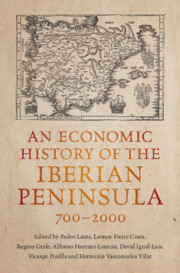Book contents
- An Economic History of the Iberian Peninsula, 700–2000
- An Economic History of the Iberian Peninsula, 700–2000
- Copyright page
- Contents
- Figures
- Tables
- Contributors
- Preface: By Way of Presentation
- Introduction
- Part I The Making of Iberia, 700–1500
- Section I The Early Middle Ages, 700–1200
- Section II The Medieval Economy, 1000–1500
- 2 Production, 1000–1500
- 3 Population, 1000–1500
- 4 The Polity, 1000–1500
- 5 Money, Credit and Banking, 1000–1500
- 6 Technology, 1000–1500
- 7 Living Standards, 1000–1500
- 8 International Trade and Commerce, 1000–1500
- 9 The Iberian Economy in Global Perspective, 700–1500
- Part II Globalization and Enlightenment, 1500–1800
- Part III Industrialization and Catching Up, 1800–2000
- References
- Index
7 - Living Standards, 1000–1500
from Section II - The Medieval Economy, 1000–1500
Published online by Cambridge University Press: 22 February 2024
- An Economic History of the Iberian Peninsula, 700–2000
- An Economic History of the Iberian Peninsula, 700–2000
- Copyright page
- Contents
- Figures
- Tables
- Contributors
- Preface: By Way of Presentation
- Introduction
- Part I The Making of Iberia, 700–1500
- Section I The Early Middle Ages, 700–1200
- Section II The Medieval Economy, 1000–1500
- 2 Production, 1000–1500
- 3 Population, 1000–1500
- 4 The Polity, 1000–1500
- 5 Money, Credit and Banking, 1000–1500
- 6 Technology, 1000–1500
- 7 Living Standards, 1000–1500
- 8 International Trade and Commerce, 1000–1500
- 9 The Iberian Economy in Global Perspective, 700–1500
- Part II Globalization and Enlightenment, 1500–1800
- Part III Industrialization and Catching Up, 1800–2000
- References
- Index
Summary
By the year 1000 the Andalusian caliphate constituted a highly urbanized society, where the largest cities in Europe were located, while the economy of the Christian kingdoms of Iberia was characterized by a low level of urbanization and a poor market development. Five hundred years later, the territory of al-Andalus had disappeared and its economy had been absorbed and transformed into the Christian kingdoms. The latter’s territorial expansion was marked by the growth of cities, the impact of trade on the agrarian economy and an increase in rural stratification that, at different levels, made the market important for the satisfaction of needs and peasant consumption. In the Christian kingdoms, a strong increase in noble spending, emulated by urban elites, dedicated to the conspicuous consumption of products partially purchased on the international market, occurred throughout the period. After the Black Death, with the consolidation of a rural elite, important sectors of the population were attracted by the lifestyle of the urban elites. This evolution can also be detectable in the lifestyle of vast sectors of the population, in the cities as well as in the rural areas.
- Type
- Chapter
- Information
- An Economic History of the Iberian Peninsula, 700–2000 , pp. 175 - 198Publisher: Cambridge University PressPrint publication year: 2024



